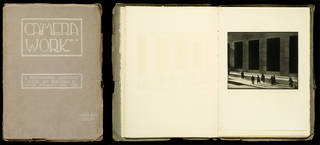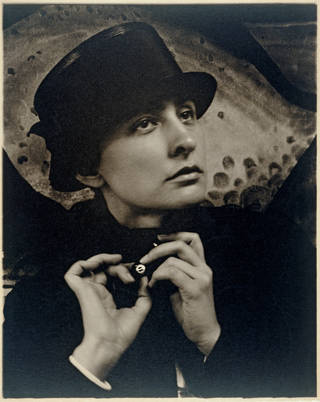Alfred Stieglitz Role in Establishing Photography as a Legitimate Art Practice
Alfred Stieglitz – pioneer of modern photography
Alfred Stieglitz (1864 – 1946) was an abet for the Modernist motion in the arts, and, arguably, the most important photographer of his time. A lensman, publisher, writer and gallery owner, he played a fundamental role in the promotion and exploration of photography every bit an fine art grade.
"Photography fascinated me, first as a toy, and so as a passion, then as an obsession."
Alfred Stieglitz
Stieglitz was a pupil in Deutschland when he bought his starting time camera, an 8 × ten plate motion picture camera that required a tripod. Despite its bulk, Stieglitz travelled throughout Europe, taking photographs of landscapes and labourers in Federal republic of germany, Italy and holland. In 1892, Stieglitz bought his first hand-held camera, a Folmer and Schwing 4 × 5 plate motion-picture show camera, which he used to take ii of his best known images, Wintertime, Fifth Avenue and The Last.


Stieglitz collected books on photography and photographers in Europe and the The states and wrote articles on the technical and aesthetic aspects of photography. Through his self-study, Stieglitz developed and refined his vision of photography as an art form.
Photograph-Secession and Photographic camera Work
In 1902, Stieglitz founded Photo-Secession, a radical and controversial movement that was influential in promoting photography as a fine art. For this group, photography was viewed not just every bit a documenting tool, just as a new way of expression and creation, whereby an paradigm could be manipulated to accomplish a subjective vision.
The ideas of Photo-Secession, and the institution of photography equally a fine fine art, were promoted through Stieglitz's Photographic camera Work, a quarterly photographic journal published from 1903 to 1917. The first issue was printed in December 1902, and like all of the subsequent problems it contained beautiful paw-pulled photogravures (a procedure that uses gelatin to transfer the paradigm from a black and white negative to a copper printing plate), critical writings on photography, and commentaries on photographers and exhibitions.
In the introduction to the first result, Stieglitz wrote:
"Only examples of such works as gives evidence of individuality and artistic worth, regardless of schoolhouse, or contains some infrequent feature of technical merit, or such equally exemplifies some treatment worthy of consideration, volition find recognition in these pages. Withal, the Pictorial will be the dominating feature of the magazine."

In 1905 Stieglitz opened the "little galleries of the Photograph-Secession" in New York at 291 Fifth Avenue, which after became known as gallery '291'. The effect of the Kickoff World War and the changes in the New York arts scene meant that in 1917 Stieglitz could no longer afford to publish Camera Piece of work or to run the gallery.
Influenced by the large abstract drawings of the American artist Georgia O'Keeffe (1887 – 1986) and the work of American photographer Paul Strand (1890 – 1976), Stieglitz adopted an arguably more Modernist approach in the 1920s and 1930s. He started to make small gelatin-silver prints of exquisite precision and sharp tonal contrast and to explore the artistic and spiritual potential of his everyday surround.

Between 1925 and 1934, Stieglitz took a series of photographs of clouds. The Equivalents, as he came to call them, are some of the first intentionally abstruse photographic works of art and have been hailed every bit his almost of import contribution to photography.
Stieglitz'southward aim was not to distill the essence of clouds but to transform them into an abstract language of form expressive of his feelings. By removing whatever reference points and allowing the photographs to exist viewed in whatsoever orientation, Stieglitz "was destabilising your [the viewer'due south] relationship with nature in society to accept you retrieve less almost nature, non to deny that information technology's a photo of a cloud, simply to think more well-nigh the feeling that the cloud formation evokes." (Sarah Greenough, 1995)

These images had a huge affect at the time, especially considering photography had only been recognised as a distinct art form for most fifteen years, and that within this curt time no tradition of abstraction had existed.
Georgia O'Keeffe
In 1916 Stieglitz starting time saw the work of the American artist Georgia O'Keeffe (1887 – 1986) and was impressed by the expressive power of her large abstract drawings.
The following yr he hosted her first solo exhibition at his gallery '291' in New York. He also started to photograph O'Keeffe, posing her in forepart of her work and finding ways to fuse her body with the compositions. This was the commencement of an extraordinary collaboration that lasted over 20 years and resulted in over 300 photographs. Stieglitz and O'Keeffe's artistic dialogue extended to a profound influence on each other'southward piece of work. They became lovers and married in 1924.

Stieglitz saw his photographs of O'Keeffe as a composite portrait. Seen together, they explore themes of multiplicity, fragmentation, time and change, as well as O'Keeffe's personality, beauty and creativity. Nosotros might also read the portraits as a record of Stieglitz and O'Keeffe's love matter and of their remarkable artistic synergy.
The portraits of O'Keeffe shown here were taken betwixt 1918 and 1937. The early, sensuous images were taken in the studio and printed on platinum and palladium paper, giving a fine tonal range. Later, in that location is a move away from symbolically charged images to an increasingly frank record of an individual.

Source: https://www.vam.ac.uk/articles/alfred-stieglitz-pioneer-of-modern-photography
Belum ada Komentar untuk "Alfred Stieglitz Role in Establishing Photography as a Legitimate Art Practice"
Posting Komentar